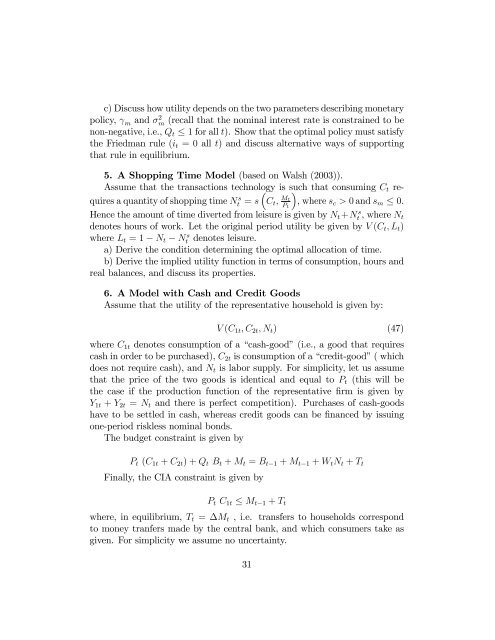Monetary Policy, Inflation, and the Business Cycle Chapter 2 A ...
Monetary Policy, Inflation, and the Business Cycle Chapter 2 A ...
Monetary Policy, Inflation, and the Business Cycle Chapter 2 A ...
Create successful ePaper yourself
Turn your PDF publications into a flip-book with our unique Google optimized e-Paper software.
c) Discuss how utility depends on <strong>the</strong> two parameters describing monetary<br />
policy, m <strong>and</strong> 2 m (recall that <strong>the</strong> nominal interest rate is constrained to be<br />
non-negative, i.e., Q t 1 for all t). Show that <strong>the</strong> optimal policy must satisfy<br />
<strong>the</strong> Friedman rule (i t = 0 all t) <strong>and</strong> discuss alternative ways of supporting<br />
that rule in equilibrium.<br />
5. A Shopping Time Model (based on Walsh (2003)).<br />
Assume that <strong>the</strong> transactions technology is such that consuming C t requires<br />
a quantity of shopping time Nt s = s C t ; Mt<br />
P t<br />
, where s c > 0 <strong>and</strong> s m 0.<br />
Hence <strong>the</strong> amount of time diverted from leisure is given by N t +Nt s , where N t<br />
denotes hours of work. Let <strong>the</strong> original period utility be given by V (C t ; L t )<br />
where L t = 1 N t Nt s denotes leisure.<br />
a) Derive <strong>the</strong> condition determining <strong>the</strong> optimal allocation of time.<br />
b) Derive <strong>the</strong> implied utility function in terms of consumption, hours <strong>and</strong><br />
real balances, <strong>and</strong> discuss its properties.<br />
6. A Model with Cash <strong>and</strong> Credit Goods<br />
Assume that <strong>the</strong> utility of <strong>the</strong> representative household is given by:<br />
V (C 1t ; C 2t ; N t ) (47)<br />
where C 1t denotes consumption of a “cash-good”(i.e., a good that requires<br />
cash in order to be purchased), C 2t is consumption of a “credit-good”( which<br />
does not require cash), <strong>and</strong> N t is labor supply. For simplicity, let us assume<br />
that <strong>the</strong> price of <strong>the</strong> two goods is identical <strong>and</strong> equal to P t (this will be<br />
<strong>the</strong> case if <strong>the</strong> production function of <strong>the</strong> representative …rm is given by<br />
Y 1t + Y 2t = N t <strong>and</strong> <strong>the</strong>re is perfect competition). Purchases of cash-goods<br />
have to be settled in cash, whereas credit goods can be …nanced by issuing<br />
one-period riskless nominal bonds.<br />
The budget constraint is given by<br />
P t (C 1t + C 2t ) + Q t B t + M t = B t 1 + M t 1 + W t N t + T t<br />
Finally, <strong>the</strong> CIA constraint is given by<br />
P t C 1t M t<br />
1 + T t<br />
where, in equilibrium, T t = M t , i.e. transfers to households correspond<br />
to money tranfers made by <strong>the</strong> central bank, <strong>and</strong> which consumers take as<br />
given. For simplicity we assume no uncertainty.<br />
31
















